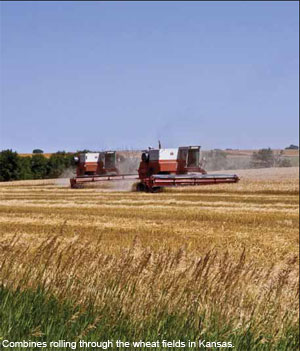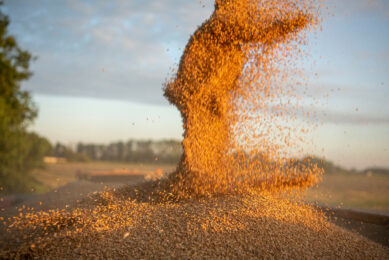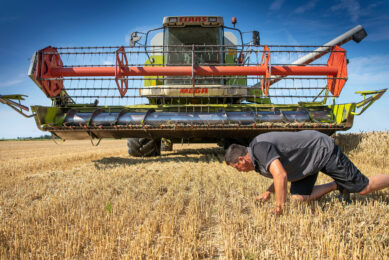American wheat is having a competitiveness problem

Wheat production and area is on a long-term downtrend in the United States. There is a general understanding in the industry that if the competitiveness problem is to be successfully addressed, application of technology that is available in other crops but not presently available in wheat will be necessary. Several US organisations dealing with wheat have submitted a paper with the central question of how theintroduction of modern genetic technology in wheat can help address a competitiveness crisis.
By Dick Ziggers
Already in June 2006 the National Association of Wheat Growers (NAWG), North American Millers’ Association, US Wheat Associates and the Wheat Export Trade Education Committee published a paper entitled “Addressing the competitiveness crisis in wheat.” The paper described a US wheat production sector that was faced with declining acreage and production; slower yield growth compared to other crops; relatively poor net margins for producers; very slow growth in domestic markets; and virtually no growth in export markets. The paper outlined some ways in which wheat industry sectors could work together to address these challenges, and served as a call to arms for a series of Wheat Summit meetings that followed. So far, initiatives have not been very successful in making wheat a preferred crop to grow.
Net return prevails
Farmers give primary consideration to net returns per acre for competing crops when making planting decisions. Figure 1 shows data from the Food and Agricultural Policy Research Institute (FAPRI) comparing the net returns for wheat, corn and soybeans. Wheat net returns are consistently half or less the net returns for either of the other two crops. This spread widened markedly in the 2007/08 and 2008/09 marketing years. The competitive problem is a longer term structural problem, not a symptom of recent volatility in commodity markets.There are also dramatic differences in yield growth trends between wheat, corn and soybeans. Data from USDA’s Economic Research Service (ERS) shows that the annual growth rate in yield for corn is four times that of annual yield growth in wheat, so the longer the industry remains on the current trendline, the deeper is the competitive hole from which wheat must extract itself. The bottom line is that farmers will produce what the market rewards. If incentives from the market encourage farmers to plant less wheat and more of other crops, that’s what they will do. Since wheat provides 20% of the world’s calories, and the United States is the world’s leading wheat exporter, ensuring that wheat is a competitive crop in the United States should be a major priority.
Declining production of wheat is a concern to the milling, baking and food businesses that rely on wheat as a primary ingredient. Smaller supplies of wheat, produced only in areas where more profitable alternatives do not exist, will translate into supply challenges for the food industry. Smaller production regions also leave the US wheat crop more vulnerable to weather or plant disease problems. To the extent that wheat production is pushed onto marginal acres, crop failures become more likely.
Opportunity costs biotechnology
The economic concept of opportunity cost is affecting wheat competitiveness compared to other crops. Dr. Bill Wilson, an agricultural economist from North Dakota State University, has compiled data documenting negative supply curve shifts for wheat production resulting from the advent of biotechnology traits in competing crops. A negative shift in a supply curve implies that at the same price, less of a product will be produced than before, or conversely, producers will require a higher price than before to produce the same quantity of wheat. While the higher price sounds attractive to producers, these changes cause concern among the rest of the wheat industry.
Wilson’s data estimate that drought tolerance in corn and/or soybeans will result in a 60¢ per bushel opportunity cost for wheat production on the same land. In other words, if the market wants to bid an acre away from these drought-tolerant corn and soybean varieties and back into wheat, the market price of wheat will need to rise by 60¢ per bushel of wheat. Wilson also estimates that the introduction of RoundUp Ready-2-Yield soybeans in 2009 will increase the opportunity cost of wheat production by approximately $1.49 per bushel of wheat. Those spreads will translate to significant costs for food companies, and if new traits continue to be introduced in other crops while wheat is left behind, those opportunity cost spreads will widen.
Producers certainly enjoy an opportunity to sell their crops at higher prices caused by short supplies. But at some point higher prices may provide an incentive for food companies to reformulate away from wheat, which would be bad news for producers.
Vulnerability to new threats
The US and other developed countries are world leaders in agricultural innovation, but if wheat researchers are precluded from using and deploying those innovations, the consequences for farmers in both developed and developing countries – to say nothing of consumers – will be dire. Aside from the challenge of meeting a growing global demand for food, an emerging wheat stem rust pathogen known as Ug99 may lend increased urgency to expanding the toolbox at plant breeders’ disposal.
This pathogen was first identified in Uganda in 1999, but has since spread to the Arabian Peninsula and Iran. It is only a matter of time before it spreads into major wheat production areas in Asia and eventually finds its way to the United States. At the present time, there is little genetic resistance to this new strain of wheat stem rust; approximately 75% of current varieties in use in the US are susceptible to Ug99. If new resistance genes cannot be found within the wheat genome, it is likely that a biotechnology solution will be necessary to provide strong and durable resistance.
Drought tolerance
How can biotechnology help solve these competitive challenges? First, it is important to note that there will be no silver bullets. No single technology can deliver on a promise to make a crop competitive. However, the rapid adoption of biotechnology traits in other crops in many producing countries around the world, and grower testimonials in support of these traits, lends credence to the idea that biotechnology can make a significant contribution. The highest priorities for trait development are in the area of abiotic stress tolerance, and in particular, tolerance to drought. Water availability is becoming a major sustainability issue for agriculture, and traits that would allow production of more wheat with less water would be very beneficial to farmers and to society as a whole. Other priority traits of interest include tolerance of other sorts of abiotic stress (heat, cold, freeze), increased yields, nutrient use efficiency (particularly nitrogen) and resistance to plant diseases like stem rust, stripe rust, head blight and others. Lower on the list but still important include specific end-use or nutritional properties and herbicide tolerance. Productivity is the overriding theme of all of these traits. The general public is also raising its expectations for meeting sustainability goals in agricultural production. The Field to Market (FTM) coalition, of which NAWG is a member, is attempting to define and establish objective measurements for sustainability in agriculture. FTM defines sustainable agriculture as “meeting the needs of the present while improving the ability of future generations to meet their own needs,” focusing on three specific critical outcomes:
1. Increasing productivity to meet future nutritional needs while decreasing impacts on the environment, including water, soil, habitat, air quality and climate emissions, and land use;
2. Improving human health through access to safe, nutritious food; and
3. Improving the social and economic well-being of agricultural communities.
Biotechnology traits can contribute to all three of these critical outcomes, and in so doing, enable the wheat industry to meet expectations from society for abundant, high-quality, safe food at competitive prices, produced in a sustainable way.
Consumer opinions
In the US the majority of consumers have no or little problems with food biotechnology. Communicating specific benefits may enhance perception. The majority of consumers would purchase foods from plants produced through biotechnology for specific benefits. Consumer opinion in foreign markets is more variable. Some markets in Latin America express little concern so long as food safety and quality considerations are met satisfactorily. Other markets, primarily in Europe and North Asia, register a much higher level of consumer concern. Communication is key. A summary comment from a survey of the Asian Food Information Council conducted (Dec, 2008) is particularly illustrative: “The survey underscores the fact that learning about the benefits of biotech foods has a significant impact on consumers’ perception and acceptance. Science-based information promoting an understanding of the benefits of biotechnology foods should be communicated to the public, using non-technical, easy to understand language. In today’s environment the benefits of biotechnology in the context of sustainable production of food has dramatically increased in importance. Education programmes need to include information on this aspect of biotechnology as well as the quality, safety and nutritional benefits.”
Choice
Customers make choices with the money they spend on food, and the most important aspect of food production systems is to provide what customers demand.
While a tolerance of zero is not achievable in biological systems, wheat supplies that meet commercial criteria as non-biotech will be available to customers and will be marketed with premiums and discounts. With commercially-achievable tolerances for low level presence, the grain handling industry will be able to meet customer demands for non-biotech wheat. Buyers and sellers will determine the terms for these arrangements.
Comprehensive evaluation of food safety effects prior to commercialisation will also be very important.
Biotechnology can make a significant contribution to changing this competitiveness equation and positioning wheat as a viable production alternative for producers. If these new technologies are available in other crops but not in wheat, the wheat production sector will continue its acreage and production decline towards the status of a minor crop.
Monsanto takes wheat in portfolio
GM company Monsanto Company this year expanded its seeds and traits portfolio to include wheat. The company has acquired the assets of WestBred, LLC, a Montana-based company that specialises in wheat germplasm, the crop’s seed genetic material. The company believes the acquisition will bolster the future growth of Monsanto’s seeds and traits platform and allow farmers to benefit from the company’s experience in drought-, disease- and pest-tolerance innovations.
Source: FeedTech vol 14 nr 1, 2010











